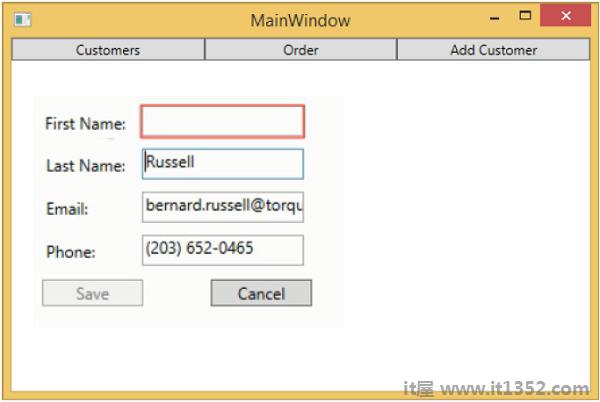在本章中,我们将简要讨论依赖注入.我们已经介绍了数据绑定将视图和ViewModel彼此分离,这使得它们能够在不明确通知通信另一端发生了什么的情况下进行通信.
现在我们需要类似于将我们的ViewModel与客户端服务分离.
在面向对象编程的早期,开发人员面临着在应用程序中创建和检索类实例的问题.针对这个问题已经提出了各种解决方案.
在过去几年中,依赖注入和控制反转(IoC)在开发人员中越来越受欢迎,并且优先于某些旧的解决方案,如单例模式.
IoC和依赖注入是两种密切相关的设计模式,容器基本上是一个块为你做这两种模式的基础设施代码.
IoC模式是关于委托建设和依赖注入的责任模式是关于为已经构建的对象提供依赖关系.
它们都可以被视为构建的两阶段方法.当你使用一个容器时,容器会承担以下几个职责:
它会在被问到时构造一个对象.
容器将确定该对象所依赖的内容.
构造这些依赖项.
将它们注入到对象中
递归处理.
<让我们看一下如何使用依赖注入来打破ViewModel和客户端服务之间的分离.我们将使用与之相关的依赖注入来连接保存处理AddEditCustomerViewModel表单.
首先,我们需要在Services文件夹中的项目中创建一个新接口.如果项目中没有services文件夹,则先创建它,然后在Services文件夹中添加以下界面.
using MVVMHierarchiesDemo.Model;
using System;
using System.Collections.Generic;
using System.Linq;
using System.Text;
using System.Threading.Tasks;
namespace MVVMHierarchiesDemo.Services {
public interface ICustomersRepository {
Task<List<Customer>> GetCustomersAsync();
Task<Customer> GetCustomerAsync(Guid id);
Task<Customer> AddCustomerAsync(Customer customer);
Task<Customer> UpdateCustomerAsync(Customer customer);
Task DeleteCustomerAsync(Guid customerId);
}
}以下是ICustomersRepository的实现.
using MVVMHierarchiesDemo.Model;
using System;
using System.Collections.Generic;
using System.Linq; using System.Text;
using System.Threading.Tasks;
namespace MVVMHierarchiesDemo.Services {
public class CustomersRepository : ICustomersRepository {
ZzaDbContext _context = new ZzaDbContext();
public Task<List<Customer>> GetCustomersAsync() {
return _context.Customers.ToListAsync();
}
public Task<Customer> GetCustomerAsync(Guid id) {
return _context.Customers.FirstOrDefaultAsync(c => c.Id == id);
}
public async Task<Customer> AddCustomerAsync(Customer customer){
_context.Customers.Add(customer);
await _context.SaveChangesAsync();
return customer;
}
public async Task<Customer> UpdateCustomerAsync(Customer customer) {
if (!_context.Customers.Local.Any(c => c.Id == customer.Id)) {
_context.Customers.Attach(customer);
}
_context.Entry(customer).State = EntityState.Modified;
await _context.SaveChangesAsync();
return customer;
}
public async Task DeleteCustomerAsync(Guid customerId) {
var customer = _context.Customers.FirstOrDefault(c => c.Id == customerId);
if (customer != null) {
_context.Customers.Remove(customer);
}
await _context.SaveChangesAsync();
}
}
}执行保存处理的简单方法是在AddEditCustomerViewModel中添加新的ICustomersRepository实例并重载AddEditCustomerViewModel和CustomerListViewModel构造函数.
private ICustomersRepository _repo;
public AddEditCustomerViewModel(ICustomersRepository repo) {
_repo = repo;
CancelCommand = new MyIcommand(OnCancel);
SaveCommand = new MyIcommand(OnSave, CanSave);
}更新OnSave方法,如下面的代码所示.
private async void OnSave() {
UpdateCustomer(Customer, _editingCustomer);
if (EditMode)
await _repo.UpdateCustomerAsync(_editingCustomer);
else
await _repo.AddCustomerAsync(_editingCustomer);
Done();
}
private void UpdateCustomer(SimpleEditableCustomer source, Customer target) {
target.FirstName = source.FirstName;
target.LastName = source.LastName;
target.Phone = source.Phone;
target.Email = source.Email;
}以下是完整的AddEditCustomerViewModel.
using MVVMHierarchiesDemo.Model;
using MVVMHierarchiesDemo.Services;
using System;
using System.Collections.Generic;
using System.Linq;
using System.Text;
using System.Threading.Tasks;
namespace MVVMHierarchiesDemo.ViewModel {
class AddEditCustomerViewModel : BindableBase {
private ICustomersRepository _repo;
public AddEditCustomerViewModel(ICustomersRepository repo) {
_repo = repo;
CancelCommand = new MyIcommand(OnCancel);
SaveCommand = new MyIcommand(OnSave, CanSave);
}
private bool _EditMode;
public bool EditMode {
get { return _EditMode; }
set { SetProperty(ref _EditMode, value); }
}
private SimpleEditableCustomer _Customer;
public SimpleEditableCustomer Customer {
get { return _Customer; }
set { SetProperty(ref _Customer, value); }
}
private Customer _editingCustomer = null;
public void SetCustomer(Customer cust) {
_editingCustomer = cust;
if (Customer != null) Customer.ErrorsChanged -= RaiseCanExecuteChanged;
Customer = new SimpleEditableCustomer();
Customer.ErrorsChanged += RaiseCanExecuteChanged;
CopyCustomer(cust, Customer);
}
private void RaiseCanExecuteChanged(object sender, EventArgs e) {
SaveCommand.RaiseCanExecuteChanged();
}
public MyIcommand CancelCommand { get; private set; }
public MyIcommand SaveCommand { get; private set; }
public event Action Done = delegate { };
private void OnCancel() {
Done();
}
private async void OnSave() {
UpdateCustomer(Customer, _editingCustomer);
if (EditMode)
await _repo.UpdateCustomerAsync(_editingCustomer);
else
await _repo.AddCustomerAsync(_editingCustomer);
Done();
}
private void UpdateCustomer(SimpleEditableCustomer source, Customer target) {
target.FirstName = source.FirstName;
target.LastName = source.LastName;
target.Phone = source.Phone;
target.Email = source.Email;
}
private bool CanSave() {
return !Customer.HasErrors;
}
private void CopyCustomer(Customer source, SimpleEditableCustomer target) {
target.Id = source.Id;
if (EditMode) {
target.FirstName = source.FirstName;
target.LastName = source.LastName;
target.Phone = source.Phone;
target.Email = source.Email;
}
}
}
}编译执行上述代码时,您会看到相同的输出,但现在ViewModes更松散地解耦.

按"添加客户"按钮后,您将看到以下视图.当用户将任何字段留空时,它将突出显示并且保存按钮将被禁用.
